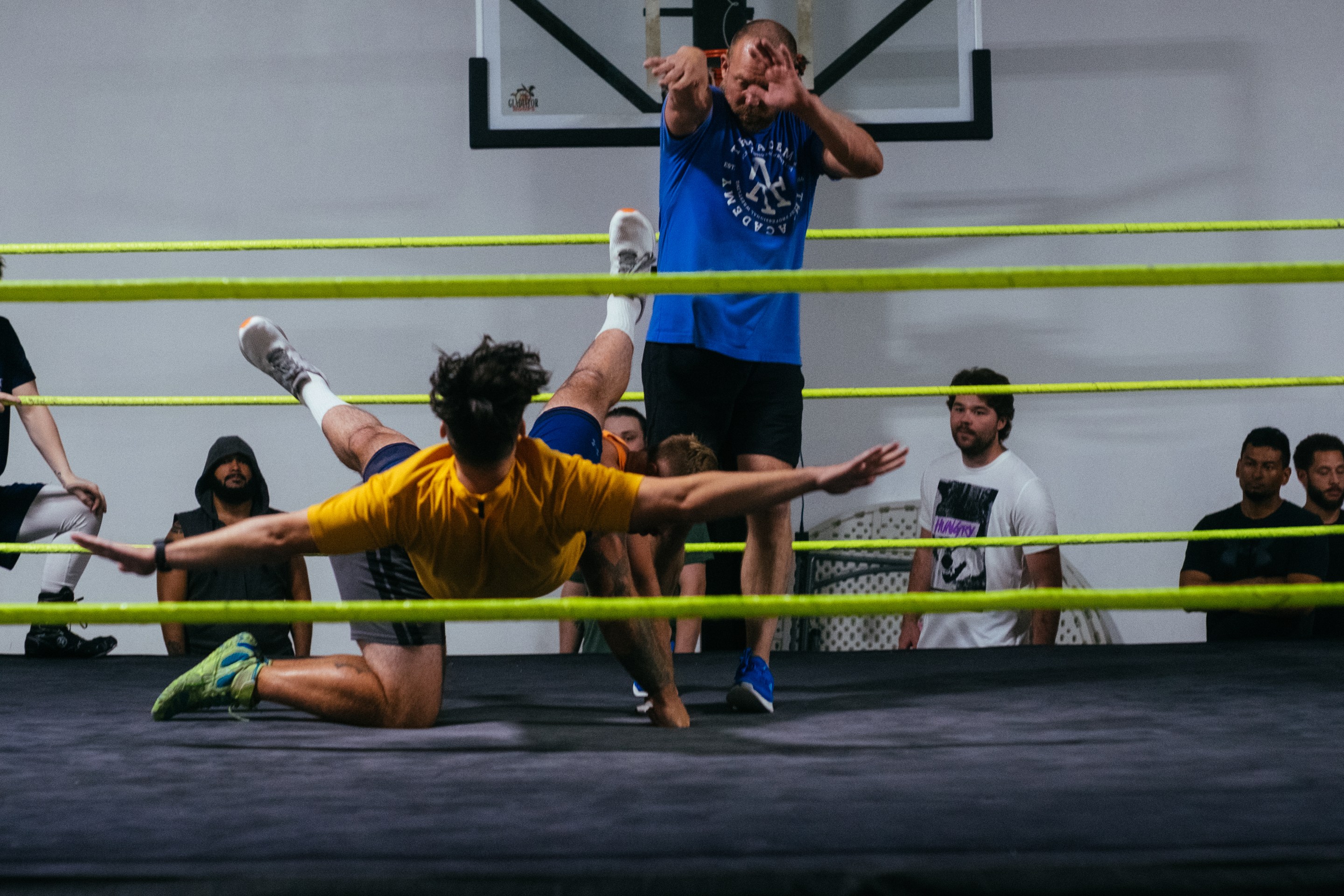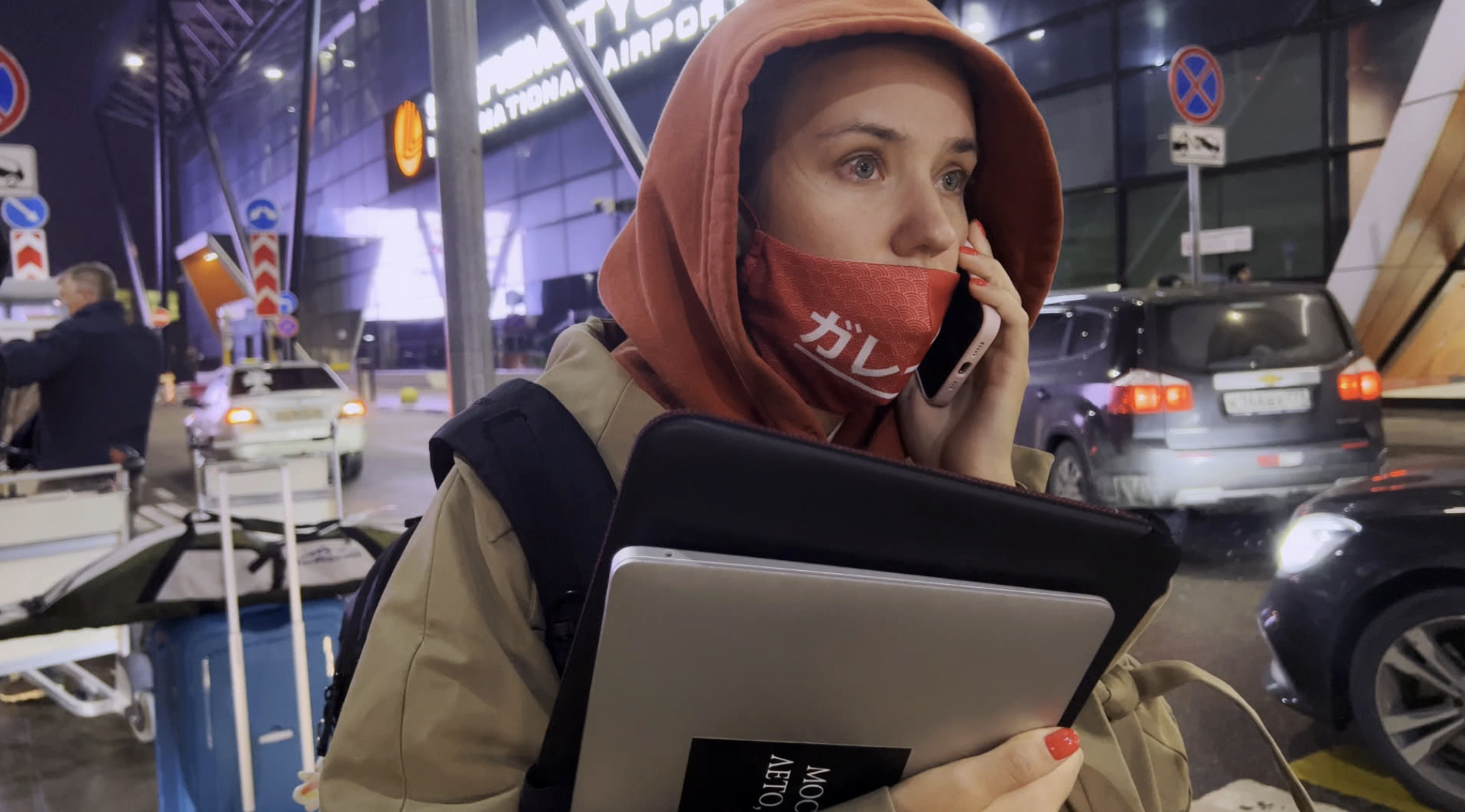“Tuck your chin and slap the mat.”
It’s the first night for a brand-new class of wrestling students at The Academy: School of Professional Wrestling. I’m one of roughly 20 men and women gathered around a 20’ x 20’ ring tucked away in a back corner of Element Gym in St. Paul, anxiously waiting for my opportunity to take my first bump.
Bumps are simple theater, but they’re essential moments in the sport of pro wrestling. The idea is to simply drop—to hit the mat with as much force as possible, making as much sound as possible—without actually hurting yourself.
As a lifelong wrestling fan, I’ve seen hundreds of wrestlers take hundreds of thousands of bumps in the ring and pop back up unscathed. Ken Anderson, the former WWE and TNA champion known to wrestling fans as Ken Kennedy, has been training wrestling junkies like me to do this exact thing since he co-founded The Academy in 2016, spinning out regulars on WWE, All Elite Wrestling, and the Minnesota independent circuit.
I stand with my arms crossed on my chest where Anderson places his palm. His hand is thick, and his scalp is covered in knots and scars from years of falls like this. He’s in tights, speaking calmly, like he’s not about to thrust me six feet backward.
“Tuck your chin and slap the mat.”
I give the nod and Anderson pushes my chest, carefully guiding me backwards over Damon Luken, one of The Academy’s experienced students, who is crouched behind me on all fours. The setup is supposed to help me control my body in the fall, but the only thing that slaps the mat is the heel of my skull. I’m seeing stars, but I rebound quickly to try and hide it. As I roll out of the ring, R.J. Wilkins, a graduate of the 2022 class, offers some reassurance: “Once you know how that feels, you won’t do it again.”
Most students at The Academy train twice a week for five or six months before having a real match. At 40 years old, I don’t have the time or commitment level of most students. I’m here to live out that childhood fantasy of putting on one, single match, and Anderson has five weeks to get me and my writing partner, Jerard Fagerberg, ready to go against one another in front of a crowd of friends, family, and most nerve-wracking of all—our fellow students.
Jerard’s Wrestling Diary, Week 1: Nothing Hurts like Wrestling
Wrestling is an insular world, one defined by hierarchy and etiquette. I was a voracious wrestling fan until college, but it wasn’t until I started reporting on the sport five years ago that I learned how embedded that hierarchy is. Being inside the gym with people who’ve traveled the world learning the norms, it’s intimidating.
I’ve heard stories of old-school trainers trying to break recruits on their first day. To make them run ropes until they puke through them. Test their mettle or, just as good, make them quit. Anderson’s classes aren’t like that—though that doesn’t mean there aren't peculiarities to learn. Early in the first class, he levels the field and runs through the rules of The Academy.
“Number one: Be safe,” he says. “Number two: Don’t be a dick. If I could make that number one, I would.”
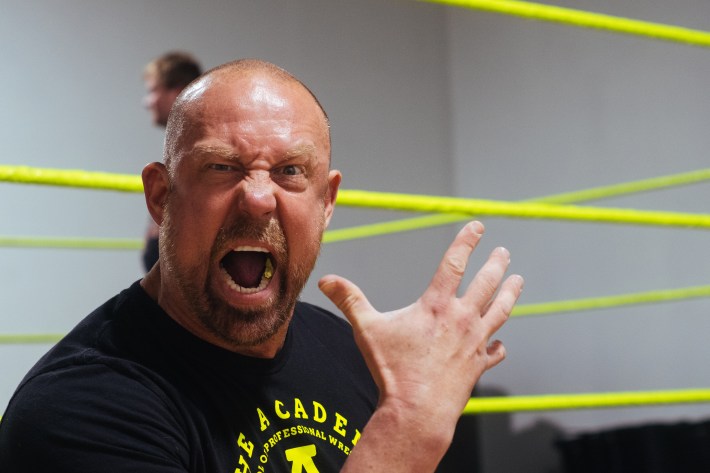
When you walk in the gym, you have to shake everyone's hand. Everyone’s. You have to wipe your feet on the apron before you step on the mat. No stealing from other people’s bags. Anderson goes through a dozen other points before Jason “Jason Rage” Nemitz chimes in with one of his own:
“Wash your ass.”
If you could draw a wrestling fan from your imagination, Nemitz, 20, is what you would conjure. The six-month student more closely resembles a Gamestop employee than the oiled bodies you see on WWE Monday Night Raw. He wears the T-shirts of thrash metal bands to class, gabbing excitedly about hardcore wrestling companies. When we go around sharing our inspiration for getting into wrestling, he tells the class he dreams of crashing through guardrails and barbed wire tables.
Others would be happy wrestling once or catching on with a local promotion. Still others have their sights fixed firmly on primetime television. Anderson takes all comers—something that has drawn criticism from others in the wrestling world—but he sees The Academy as a launchpad for anything from wish fulfillment to superstardom.
“Pretty much anybody can come in here and train,” he says. “My attitude is, if someone wants to contribute to our business, who am I to stand in the way of their dreams?”
The only true pro wrestling school in Minnesota, The Academy was founded by Anderson and fellow WWE castoff Shawn Daivari in St. Paul in 2016 before moving to Brooklyn Park. In the time since, he’s developed a decorated roster of past and current students, from AEW’s Dante and Darius Martin to independent wrestling sensation Devon Monroe. Even Olympic gold medalist Gable Stevenson trained there for his impending WWE debut.
But much has changed since The Academy opened its doors. Daivari departed the school in 2018, and other high-profile trainers like Molly Holly and Arik Cannon have come and gone from the promotion in recent years. When Patrick and I show up, The Academy is rising out of the darkest point in its six-year history. During the COVID-19 pandemic, prospects complained of being unable to reach Anderson, who had surreptitiously left the Brooklyn Park gym. Pro wrestling trade publications picked up the story, accusing him of scamming students out of the $2,950 the school charges for an eight-month course.
Anderson takes full responsibility for failing to do right by his customers during the COVID surges. He claims he’s made good with all those affected by his mismanagement, save for one student he can’t reach. Last February, he reopened the school at St. Paul’s Element Gym, and he’s been steaming ahead ever since. The Academy is now partnered with Midwest All-Star Wrestling, who signed a deal to air a Saturday night show broadcast from Element in April. The upswing has revived Anderson, who is cozier than ever with WWE. In fact, two Academy grads just returned from a tryout at the brand’s Florida training facility in late October.
Intro classes take place every Monday and Wednesday from 6 to 9 p.m. And they always start with squats. Today, we begin with 150, which is 140 more squats than I’ve done in the past year. But in wrestling, communion is forged in overcoming pain. Nathan O'Donnell, a 22-year-old new student, collapses somewhere around 110, but the whole room cheers him back to his feet.
Legs deadened, we get in the ring to practice rolls. We go forward and back, over each shoulder. It may look like adult tumbling class, but these movements are essential to understanding how to navigate the ring. I take my first couple run-throughs like a man being thrown out of a low-speed automobile. At 33 years old, I am utterly stymied by a backwards somersault, while others, like 19-year-old Kyle Buley, pop up off the mat like a gymnast.
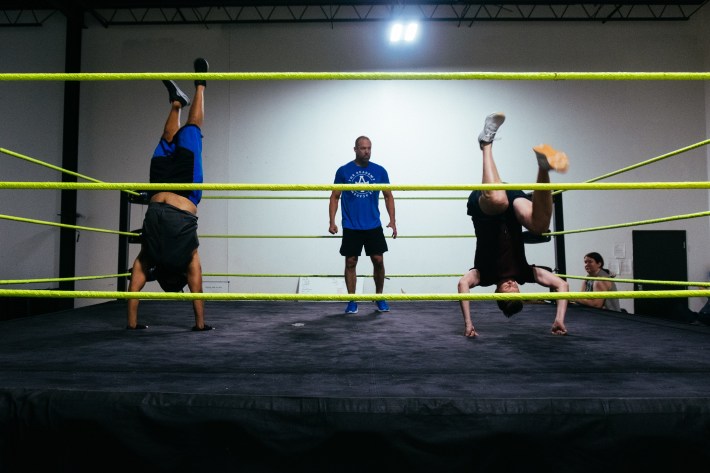
“Taking back bumps, doing the rolls, running the ropes: It’s not natural for someone to want to do that,” Nemitz says. “Your body’s adjusting to trauma, adjusting to damage, and building a callous around it.”
Several students don’t quite get it, but Anderson is patient. He talks close, making adjustments until the student gets it right enough. A passable effort is met with a chorus of claps from the others.
It’s a long night, full of new kinds of discomfort. Every bit of contact with the mat echoes through my body. I wake in the morning leadened with the kind of ache Nemitz warns of: My lower body is immobile, my joints crinkle like tinfoil, and my head is thirsty for adrenaline.
In the mirror, I examine the two-foot bruise across my shoulders. I can see the grain of the ropes embossed in the purple, blue, and yellow. I text Patrick in adolescent glee.
Patrick’s Wrestling Diary, Week 2: A Fight for Position
Following a lackluster debut, I’m excited to get back in the ring. While I’ve been sore for the past week, I take solace in the fact that I made it through the first class without getting injured. After talking with some of my fellow students, I realize pain is a prerequisite for a life in wrestling.
“[Getting hurt] happens every single day,” says the teenage Buley, who’s been training at The Academy since March. “Today, we did a drill where one person sweeps the other person’s legs out from under them. The first one we did, I knocked my head into the mat. It hurts. I knew it was going to hurt, and it hurts.”
This year, Buley made the decision to move from his home town of Roseau, six hours north of the Twin Cities, to pursue his passion. Despite being barely old enough to vote, he's confident that he’s destined for the life of a wrestler. He’s watched as his classmates and friends in The Academy have signed with major organizations, proving that wrestling on the big stage isn’t just a pipe dream.
“I know I still have a lot of work to do, but I’m only 19, I’ve got time,” Buley says, taking a brief pause from a post-class workout.
Jerard and I, on the other hand, don’t have time. This week, we kick things off with 200 squats, followed by another round of rolls and bumps to warm up. Things are beginning to feel more natural, and my confidence is growing—until we’re also introduced to monkey rolls. In this drill, three students lie on their stomachs. The person in the middle rolls to the right, toward one of the students, who must jump up and over, and continue rolling into the next person, who jumps up and over. It's like three-card monte with human bodies, and it makes me regret having lungs.
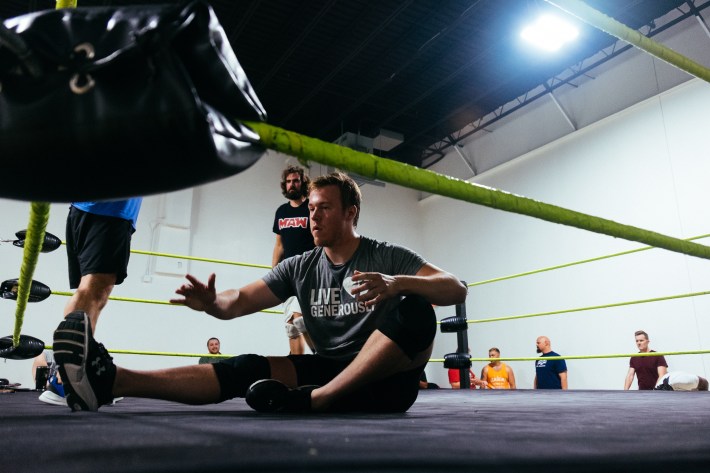
Next, Anderson is showing us basic lockups. The collar-and-elbow lockup has been one of the lasting hallmarks of pro wrestling since the art form's circus days. The sight of two titans, gripping each other by the neck and elbow, struggling for position, sets the tone for the match. These nose-to-nose moments are the crucible of wrestling storytelling. Here, wrestlers can transition into hundreds of moves, depending on the desired outcome. It’s also a way for them to communicate with each other, mouths obscured, and coordinate the next spots.
It starts by circling the ring at the same pace as your opponent and staying loose until the very moment you initiate contact. Anderson adjusts the positioning of our hands and heads, and warns us about smacking our skulls together. But most importantly, he emphasizes how to get the crowd invested in a maneuver that most wrestling fans take for granted.
“It’s supposed to look like a struggle,” he explains, while Jerard and I are busy breathing in each other's faces. “You need to make it look like you’re really fighting for position, but still stay light on your feet and let your opponent know you’re comfortable and prepared to work together.”
The lockup also serves as the starting point for a drill that Anderson calls the Kylie Rae. Named for the proficient Illinois-born wrestler who introduced the drill in an Academy workshop, the Kylie Rae is a crash course in chain wrestling, wherein holds are traded and reversed between wrestlers like a game of grappler’s chess. One wrestler reverses out into a waist lock. The other reverses. Then a wrist lock. Another reversal, where the wrist is turned behind the opponent into a hammer lock. Another reversal, ending in a standard headlock.
While we stumble our way through the first few rotations, Jerard and I are both clearly pumped full of adrenaline the entire time. Jerard says to me, “It feels like we’re really wrestling.”
Throughout the night, Anderson gives us a level of attention that far outpaces our experience, goals, and skill level. He’s not trying to break us down, but he’s also not letting us yank on each other’s limbs without guidance. His patience and genuine interest in sharing his knowledge of wrestling not only provides a sense of self-confidence but also removes some of the intimidation factor in a business that prides itself on machismo.
“I used to have a podcast, and I interviewed [former WWE tag champion] Billy Gunn,” Anderson shares during a rest. “He told me how when he was just starting out trainers would just beat the shit out of him. That’s kind of how mine was too. It was like, ‘Let’s beat on these guys and see if they want it bad enough to come back the next day.’ I don’t really agree with that, because if I beat you guys up and you don’t come back, that doesn’t help anyone.”
I’m starting to feel guilty about just how much energy Anderson, as well as the other students in the class, are putting into helping us learn the craft. Every moment we’re in the ring is a moment that others aren’t getting to chase their actual dream. But this is par for the course when it comes to training at The Academy.
“The coaches focus on you, and tell you straight up if you’ve done something bad. But I like it, honestly,” says Omar Bati, a lean, athletically built Somali student who drives each week from St. Cloud. “It’s all very professional, and you know that they are pushing you because they want you to be great.”
While greatness might not be in the cards for us, the week’s session combined with the stories of some of my fellow wrestlers-in-training have left me far more optimistic than last time.
Jerard’s Wrestling Diary, Week 3: The Drizzling Shits
Everyone wants to do the big moves. To stand tall over a vanquished opponent moment after sending them plummeting to the mat. But before you learn to give it, you gotta learn how to take it.
Patrick and I show up to a nearly empty gym. We’re taking the late Wednesday class, which begins at 9 p.m., and the only other students joining us are Tony Ostrom, a full-time business analyst with three kids and a 325-lb. bench press, and Devon “Prince Devo Knight” Vandeneykel and “The Seasoning” Alex Findley, a smooth MAW tag team who go by Royal Flavuh. Their goal tonight is to teach us how to take an ass kicking.
Findley and Vandeneykel are agile workers; they glide around the ring, crouching inches from the mat and making fast-twitch strikes. They teach us the duality of wrestling. You need to collaborate with your opponent. Every yank requires cooperation. Every punch requires a reaction. When Findley pushes my face into the ropes as he walks me from turnbuckle to turnbuckle, it’s on me to make it look like my cheekbones are being ground down. When Vandeneykel jams his shoulder into my abdomen, I have to come up looking sick.
“Everything's a dance, you're not working by yourself,” says Tyler “Rampage Santana” Johnson, one of the grads who tried out for WWE in October. “Something that I've learned in wrestling is that it's not just about you. You have to make sure that you're empowering everyone else, because if you look like shit, then everyone else looks like shit.”
In this class, Patrick and I are introduced to the chop, a backhand strike made flush on the chest. Chops were Ric Flair’s signature, a dramatic blow that’s emblematic of the very art of wrestling. Chops legitimately hurt—there is no way to take a forearm and palm to your tit meat without feeling it—but more importantly, they look and sound like they hurt. There’s a big, wet slap, and all it takes is a good grimace to make everyone in earshot recoil.
“I want to make sure my stuff looks real,” Johnson says, adding that he just quit his day job and is now spending all his time refining his ring skills. “I think what’s gone wrong in pro wrestling, and I’m still guilty of this, is doing shit that doesn’t make sense. I’m working on blurring the line between real and fiction.”
Even though Ostrom, Vandeneykel, and Findley send me home with handprints welted to either pectoral, Patrick and I return to another late class this week. As I’m lacing up my shoes, I see O’Donnell working in the ring with other newbies. He looks at home. He’s garrulous, a far cry from the sheepish recruit who collapsed during warmups just two weeks prior.
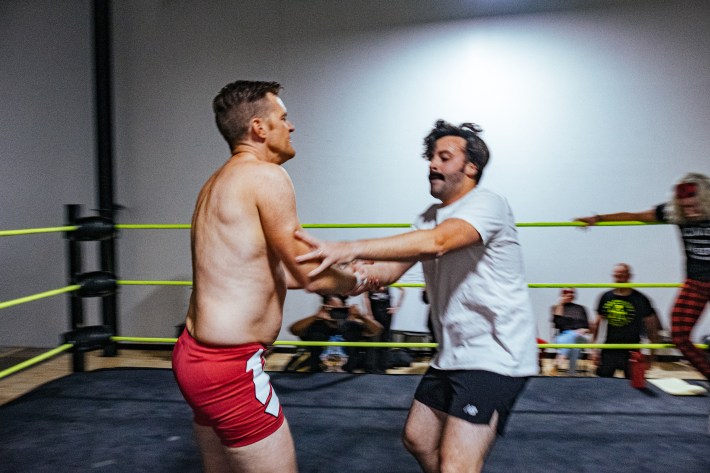
This time, it’s Morgan McLaughlin, a middle school English teacher with a forceful lucha style, and Academy grad Sterling Bond who join us. Anderson is out for the evening, and in his stead is Kaitlin Diemond, a well-traveled independent wrestling star who has been a trainer at The Academy since its reopening in March. She’s wrestled everywhere from Japan to Mexico. Often, she’s the bad cop to Anderson’s concerned dad approach.
“I can be very blunt, but I think I provide good, honest feedback,” she says. “I want to see the moves done properly, I want to see a good psychological story, and I want to believe in them. And I want them to believe in themselves. If someone doesn't believe in themselves, you can tell.”
Tonight, I’m having trouble believing. Despite McLaughlin’s teacherly patience, I can’t perform a decent looking headlock takeover. The idea is to get your opponent in a headlock, spin their body around your hips, and take them to the ground. But I can’t find the confidence to go for it. I keep whipping McLaughlin halfway by the neck but aborting it before going down, afraid of decapitating him like a dandelion. We manage to come around once, but it ends in a rough flop.
“That was the shits,” Bond says, evoking a common pro wrestling dig.
“That was mean,” Diemond replies. “But he's not wrong.”
Patrick’s Wrestling Diary, Week 4: We Trust the System
If you attend an indie wrestling show at a local bar, brewery, or high school, there’s a good chance you’re going to see the owner or principal step in the ring and play wrestler for the night. It’s tradition, and it's an easy way to get a reaction out of the home crowd. But it takes a good dancing partner to make these novices look good, and there’s a certain class of wrestlers who specialize in making even the most unathletic jokers look passable. Drew “The System” Sipila is in this class.
Sipila was born to be a wrestling bad guy. As The System, he’s the kind of mouthy prick people love to see smacked around. Between his bleached shoulder-length mop, perfectly manicured fu manchu, and ’80s teen movie charisma, Sipila has what is known in the world of wrestling as it.
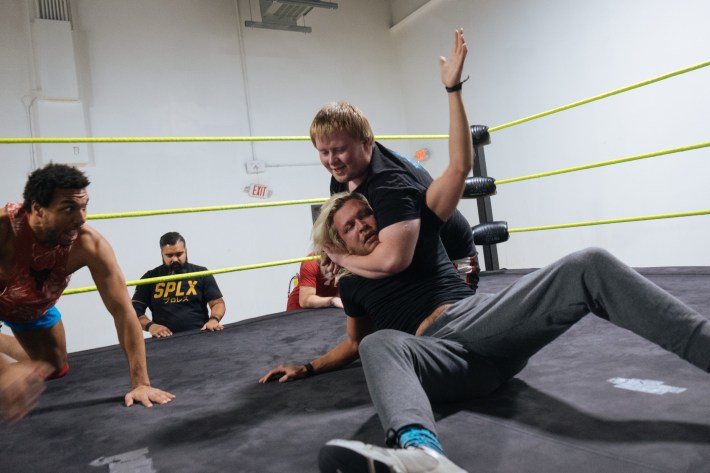
“I’ve always heard that the best wrestling characters are just a version of yourself turned up to 11,” Sipila says. “When I started [wrestling], they hadn’t given me a name, so I went with what I was known for in college. My catchphrase was ‘Trust the System,’ so I became The System.”
In real life, Sipila is a concert violinist and music instructor. As The System, he’s a shithead who comes to the ring with an alabaster violin, strumming obnoxiously in his opponents’ faces. He graduated from The Academy in February 2019, and has wrestled over 240 matches throughout his career. Today, he’s one of the brightest young wrestling prospects in Minnesota, routinely headlining in MAW.
What separates Sipila from his peers is his understanding of his character and how to suck the crowd into the match with him. He is a natural storyteller, weaving small embellishments into every hold to make it feel more real.
“There’s so much fun that goes into putting together a match,” he says. “Having a live audience in the palm of your hands is just magical.”
With not much time left until the bell rings, we know that we need someone who can help us. We know we’re the drizzling shits. We need The System.
A few days later, we’re standing in the ring listening to Sipila try and come up with a passable match that won’t look like a complete clown show. We’ve managed to draft Nemitz to serve as our fourth, following the success of his match with Sipila back on Tuesday. Sipila mutters and traces his steps, slapping his hands together to signal spots, all while managing to use the word “shit” in more inventive ways than I ever thought possible.
This is how wrestlers are. They are all nervous energy and sudden claps, pantoming holds and strikes as they pace circles on the mat.
“Okay, okay, we’ll do some arm shit… then you come in with the tag shit… heatheatheateateateat… go to the ropes…”
Jerard and I mostly stand on the apron as Sipila and Nemitz choreograph our fight. We throw in thoughts, some of which are rejected outright, others of which are adapted into the story. In all, it takes about 90 minutes to round out an elementary tag match with two newbies. Sipila and I are the bad guys—the heels—while Nemitz gets conscripted into the good-guy team with Jerard.
We run through it twice, but Sipila doesn’t take any bumps. He is nursing a sore thigh and doesn’t want to jeopardize his match this weekend. “See you in the ring,” he says as he slips out the back of the gym and into the night. Nemitz stays a bit longer and pontificates on the pros and cons of getting hit over the head with light tubes.
Jerard’s Wrestling Diary Week 5: And Then the Bell Rang
The next day, I wash my ass, as is custom. I carve my beard into a mustache and chops, reminiscent of the wrestling character I’d created in 2018 to win free tacos. I am skittering with anticipation.
Everyone gets to the gym early and goes over the match. Nemitz, tasked with remembering the steps, quizzes Patrick and I. I forget a few flourishes, but it’s mostly still there. My two-year-old daughter is coming, staying up past her bedtime to see her dad wrench another man’s arm into the ground. Patrick has gotten a spray tan, and he shows up in glitzy red gear. His wife and son are showing up to watch him get wrenched and, in the words of The System, “do some heel shit.” That’s one bar we have to clear, but there will also be a cadre of advanced students and graduates right there on the apron, watching our every spot.
Instead of describing every second of our eight-minute slaparound, I’ll just embed the video taken at ringside:
There are some thrilling highs—Patrick’s armbreaker off the second rope, splashing Sipila three times in the corner—and some despairing lows—there’s one botched sequence you’ll detect right away, even if this is the first you’ve ever heard of pro wrestling. But Nemtiz looks crafty, pirouetting in the ring and battling back to tag me in for a big moment. He gives Patrick a big slam in the middle of the ring, and Patrick remembers to tuck his chin.
And in the end, Sipila does what everyone has done since the first day I walked into The Academy. In an ending he wrote and trained me to deliver, Sipila goes for a cocky leglock and lets me take him over, flipping him into a pin. He lays down for me. The count goes one, two, three, and it’s done.
